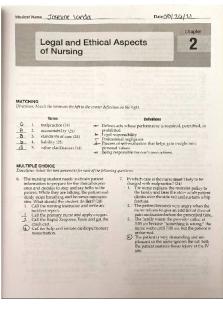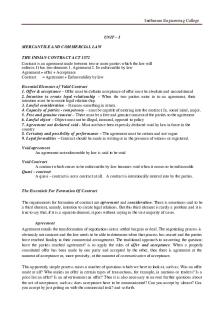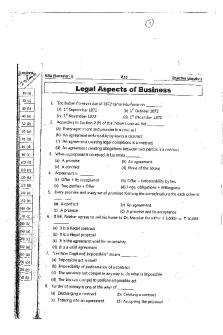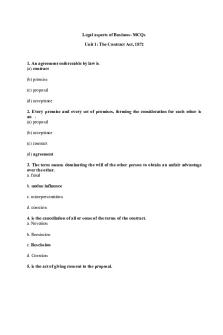Legal Aspects of Nursing PDF

| Title | Legal Aspects of Nursing |
|---|---|
| Course | MedicalSurgical I: Foundations of Nursing |
| Institution | Clemson University |
| Pages | 5 |
| File Size | 145.6 KB |
| File Type | |
| Total Downloads | 49 |
| Total Views | 158 |
Summary
legal aspects of nursing...
Description
1 NURS 3120 Legal Aspects of Nursing (p. 1-24)
INTRODUCTION: Nurses should be aware of the basic legal concepts that govern their practice because nurses are accountable for their professional judgments and actions. Knowledge of laws regulating nursing practice is necessary to: ensure nursing decisions and actions are consistent with current legal principles. protect nurses from liability. 1. REGULATION OF NURSING PRACTICE.
Nurse Practice Act - each state has a nurse practice act, which protects the public by legally defining the scope of nursing practice. o Differs from state to state
Credentialing - process of determining and maintaining competence in nursing practice. Maintains standards of practice and accountability for the educational preparation of its members. Includes licensure (simplest form of entry into your practice; enables you to practice as a nurse), certification (you desire to get added recognition for things that you know; you will be sought out as an expert on that specialty) and accreditation (governing body over all hospitals; Joint Commission) .
Standards of Care - are the skills and learning commonly possessed by members of a profession. Include the legal guidelines by which nurses should practice; there should be a skill set that you should meet and then exceed; this is internal and external o
Internal is job description and type of education required for that
o
External is joint commission guidelines, ANA, and practice act standards
2. INFORMED CONSENT.
An agreement by a patient to accept a course of treatment or a procedure after being provided complete information, including benefits and risks of treatment and alternatives; questions should be answered, but can still ask questions after signed; the person performing the procedure should be explaining the procedure and ensuring knowledge, the nurse normal witnesses the procedure Responsibility of obtaining consent lies with the person performing the procedure (MD, NP, CNS, PA, etc.). Patient must not feel coerced.-->if you do not agree with anything on the informed consent you can draw a line through it and sign next to it (i.e. it says we can photo you or examine you for education during the procedure.
2
Competent adult is 18 years of age, conscious, and oriented; age of sexual consent is 16 in South Carolina because age of consent is sixteen; If you have been married before 18, you give your own informed consent; if you are regnant before you have turned 18 you give your own informed consent; if you serve in the military you give your own consent o Confused, sedated, or disoriented adults cannot give consent. Nurse often responsible for witnessing signature; you CANNOT witness consent as a student; As a Nurse and a student nurse, if a patient has a question about a procedure once they have signed consent, you cannot answer the question about the procedure (you have to call to hold told sedation until the person performing the procedure can answer the questiondocument that you have done this)
3. DELEGATION.
“transfer of responsibility for the performance of an activity from one person to another while retaining accountability for the outcome” (ANA) area of increased litigation -Floating: being pulled off of your home base to another area where help is needed increases med errors -When nurses do not follow chain of command in the hospital it increases med errors -Right task -Right person: delegated to the right person -Right circumstances -Right direction* (this is where errors occur most) -Right supervision -Cannot delegate: teaching, assessment, formulating a plan of care
3 4. DEATH-RELATED ISSUES.
Advance health care directives - documents by which patients specify aspects of care they wish to receive in the event they become unable to make or communicate their preferences. There are two types of directives: o Living wills stipulate specific medical treatment guidelines (omission or refusing treatment) in the event the patient becomes unable to make these decisions.; if patient cannot state wishes because of mind or speech it directs wishes; comes into play if they’re unconscious or terminal ill very close to death o Health care proxy (aka durable power of attorney) appoints someone else to manage a patient’s health care treatment when the patient is unable to do so.; appointing another person “healthcare POA-power of attorney” healthcare NOT financial decisions
Do-Not-Resuscitate Orders (DNR) – aka “no code”. In the event of respiratory or cardiac arrest, the patient has expressed a desire for no resuscitation. o If you do not know a patient’s code status, then you must resuscitate until you can verify or obtain a DNR order.; on each admission the patient will have to have a new written DNA; if readmitted old “orders” are gone; if you do not have a copy of the DNA or code then you have to do a Full Code; if code called in must be two nurses witness and signed
5. TORTS - a civil wrong committed against a person or person’s property. Usually litigated by civil action for damages. Torts are intentional or unintentional. Intentional Torts: (act executed with intent or on purpose; no harm need be caused for liability). Assault - the attempt or threat of touching another person without his or her consent. Assault precedes battery. Battery - the willful touching of a person without the other's consent. False Imprisonment - unjustifiable detention of person without legal warrant to confine the person. Restraint policies, AMA (against medical advice) cannot prevent a patient from leaving the room Invasion of privacy - violating confidentiality, intruding on private patient or family matters, and sharing patient information with unauthorized persons. Defamation - communication about a person that is false or made without regard for a person’s reputation.; talking or writing something o Libel is defamation by means of print, writing, and pictures. o Slander is defamation by the spoken word, stating things that will hurt the individual. Unintentional Torts: (do not require intent, but do require the element of harm). Negligence - misconduct or practice that is below the standard expected of an ordinary, reasonable, and prudent (careful) person. The conduct puts another person at risk for harm.; carelessness
4
Malpractice – “professional negligence”; negligence on the part of a professional. Involves professional wrongdoing or remarkable lack of skill performing expected professional duties. Applies to physicians, dentists, lawyers, and usually nurses. Not processing the skill and knowledge causes harm Good Samaritan: if you stop to help, and if you follow these things you will not be charged (you can still be included in a suit but you won’t be charged) you cannot accept money, you cannot coerce the family or patient to take your care, you have to stay within your scope
5 6. LEGAL PROTECTIONS IN NURSING PRACTICE.
Good Samaritan acts - laws designed to protect health care providers who provide assistance at the scene of an emergency against claims of malpractice unless it can be shown there was a gross departure from the normal standard of care or willful wrongdoing.
Professional Liability Insurance - insurance that covers the cost if a nurse is sued for negligence.; mny tend to not renew this, but it is worth your money
Carrying out physician’s orders - nurse is responsible for validating and ensuring that an order is correct and valid for patient. Must seek clarification from prescribing physician if ambiguous or seems erroneous.; i.e. diet is regular for diabetic patient; cannot receive orders by text, can mostly by phone
Providing competent care - Nurses must provide competent, knowledgeable care. Application of the nursing process is a valuable framework in providing safe and effective patient care.; the nursing process provides your framework of care
Documentation – Patient’s record is a legal document. Failure to maintain proper documentation may constitute negligence.; the number one thing that trips nurses up
The Incident Report - aka an “unusual occurrence report” should be filled out as soon as possible after an accident occurs. It is NOT part of the patient’s medical record.; internal document that stays within your hospital (between floor, the nurse and risk management within the hospital) i.e. falls, wrong medication, etc.-->in the incidence report write what happened and what the mistake was and what should’ve happenedthe only thing you document in the chart is what you did; DO NOT put in the chart that you filed an incidence report or that it was a mistake o Date and time o Demerol 100 mg IM given for right hip pain. Dr. Jones notified. No orders received. P 78, R 20, BP 114/68. A & O x3 ___APye, RN.
Legal Responsibilities of Students - please review on page 24. o When you function as a CNA, you must stay within CNA scope which is less than that of a student nurse; do no allow nurses to ask you to go outside your scope because they know that you are a student nurse...
Similar Free PDFs

Legal Aspects of Nursing
- 5 Pages

MCQ - Legal Aspects of Business
- 25 Pages

Legal Aspects of Business MCQs
- 26 Pages

Legal uworld nursing
- 5 Pages

Legal Liabilities in Nursing
- 12 Pages

Behavioural Aspects of Budgeting
- 7 Pages
Popular Institutions
- Tinajero National High School - Annex
- Politeknik Caltex Riau
- Yokohama City University
- SGT University
- University of Al-Qadisiyah
- Divine Word College of Vigan
- Techniek College Rotterdam
- Universidade de Santiago
- Universiti Teknologi MARA Cawangan Johor Kampus Pasir Gudang
- Poltekkes Kemenkes Yogyakarta
- Baguio City National High School
- Colegio san marcos
- preparatoria uno
- Centro de Bachillerato Tecnológico Industrial y de Servicios No. 107
- Dalian Maritime University
- Quang Trung Secondary School
- Colegio Tecnológico en Informática
- Corporación Regional de Educación Superior
- Grupo CEDVA
- Dar Al Uloom University
- Centro de Estudios Preuniversitarios de la Universidad Nacional de Ingeniería
- 上智大学
- Aakash International School, Nuna Majara
- San Felipe Neri Catholic School
- Kang Chiao International School - New Taipei City
- Misamis Occidental National High School
- Institución Educativa Escuela Normal Juan Ladrilleros
- Kolehiyo ng Pantukan
- Batanes State College
- Instituto Continental
- Sekolah Menengah Kejuruan Kesehatan Kaltara (Tarakan)
- Colegio de La Inmaculada Concepcion - Cebu









